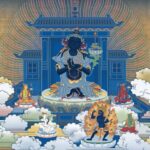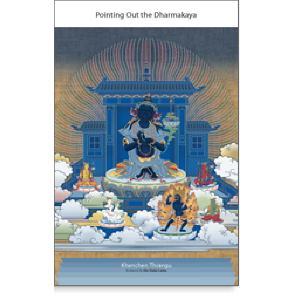| The following article is from the Autumn, 2003 issue of the Snow Lion Newsletter and is for historical reference only. You can see this in context of the original newsletter here. |
At the heart of successful Mahamudra practice is the ability to get directly at the nature of mind. The 9th Karmapa was the acknowledged master of this approach. No more authoritative instructions exist than the three texts he wrote. This easy-to-use, practical manual, which serves also as an indispensable companion to The Ocean of Definitive Meaning, the most detailed of his texts, is so clearly laid out that the instructions are easy to recall and put to use.
Brilliant explanations by Khenchen Thrangu Rinpoche, tutor of the young 17th Karmapa, make the text vividly relevant for contemporary Western practitioners.

"A clear and thorough guide."—The Dalai Lama
"Khenchen Thrangu Rinpoche is among the wisest and most compassionate Buddhist masters alive today."—Pema Chodron, author of When Things Fall Apart
Here is an excerpt from the Introduction:

Now, we will look at the first way of pointing out, which I'm going to present in the hopes that it will help your meditation practice.
When you practice the first of the five ways of looking at the mind, what will you experience? When you are looking at your mind, will you actually see a thing? Is there a thing to discover about which you can then say, This is the mind that I have seen? No, there is nothing like that. Because there is no thing that we can call the mind, the Buddha talked of emptiness and selflessness. If in fact the mind did consist of some concrete thing that we could point to and call mind, then the Buddha would not have characterized it as empty and selfless. In the terminology of philosophy, we would say that this is the absence of true existence of the mind. The point of this is that no matter how much you look at the mind, and no matter what you may expect to find, you will not find a thing of any kind. And your not finding such a thing is not because you do not know how to look at the mind, or because you are not looking hard enough; it is simply because that is how it is, There is no thing, no substantial existence within the mind. It was therefore said by the Third Gyalwa Karmapa, It does not exist and has not been seen by any of the Victorious Ones. Because there is no substantial existence within or to the mind, then no Buddha of the past, present, or future has, does, or will see such a thing in it.
There is nothing to see when you took at the mind, but on the other hand, there is not an absolute absence of anything either. Normally, when we talk about emptiness we generate a concept of absolute nothingness, absolute non-existence, as for example, the horns of a rabbit or the emptiness of empty space. The emptiness that is the mind's nature is not like that either. It is not an absolute nothingness. For example, when you look at the mind within the context of shamatha practice, then you do not see color, shape, or any kind of substantial characteristic in that way. But that is not the discovery of an absolute nothingness, because this emptiness that is the mind's nature is not insentient. It is at the same time a cognition and a cognitive capacity, because it is, in fact, that which can and does know experience.
So from one point of view, you can't say it's merely empty, because there is cognition, but you can't say there's something there, either, because there are no substantial characteristics—no color, no shape, in fact nothing to grasp whatsoever. There is nothing you can fixate on, nothing you'can label or designate accurately. Because of this, we say the mind is empty. Not only the mind, of course, but all things are empty. The reason we look at the mind is that the mind is obviously empty. Besides, the mind's emptiness can recognize itself. That's why we say it's not merely empty; its emptiness is, at the same time, a clear lucidity, a very clean lucidity. This term lucidity' is sometimes misunderstood. It always has a connotation of light, which is often misunderstood as being a kind of visual experience of physical light. Which it is not. It's simply the cognitive lucidity of your mind.
When you look at the nature of your mind, you see that its essential nature is emptiness. But this does not make your mind nonexistent, and make your body, therefore, a corpse. For while the nature of your mind is emptiness, it also has this natural characteristic of cognitive lucidity, and in fact, this cognitive lucidity which characterizes the mind is inseparable from the emptiness which is its fundamental nature. Therefore, after saying, It does not exist and has not been seen by any of the Victorious Ones, the Third Karmapa goes on to say, It does not not-exist, it is the basis of samsara and nirvana. Although the mind is empty in the sense of being devoid of any kind of substantial existence, it nevertheless is the ground for all of the qualities of Buddhahood and for all of the confusion of samsara. So, you would have to say, finally, that it is beyond being something or nothing. You cannot say the mind is something because it has no substantial characteristics that make it meaningful to view it that way. Nor can you say that it is nothing, because it is the ground for all qualities and the ground of experience. Therefore, the mind is said to be beyond being something or nothing, beyond existence and non-existence. One of the implications of this is that when looking at the mind you have no need to pretend that that which exists does not exist, or that that which does not exist, does exist. You simply see the mind as it IS.
When you rest in this experience of the mind, which is beyond extremes or elaborations, what is the experience of that like? It is characterized by a profound state of ease, which means an absence of agitation or discomfort. Therefore the experience is comfortable and pleasant. The term comfortable does not indicate pleasure in the sense of something you're attached to, or the pleasure of acting out an attachment or passion. It's simply the absence of any kind of discomfort or imperfection in the nature of mind itself. Therefore, the experience of that nature is characterized by comfy blissfulness. This is as close as we can come in words to what you experience when you look at your mind. You couldn't actually communicate what you experience. It's beyond expression. In fact, the Buddha said that this nature is the Prajnaparamita that is inexpressible, indescribable, and even inconceivable. If it had substantial characteristics, for example, if it had a color, at least you could say, it's blue or it's yellow or it's red. And if it either existed or it didn't, then you could say it exists or it doesn't exist. But it's beyond any of that. Therefore, you can't accurately say anything about it. Therefore, it was characterized by Marpa the Translator as being like the situation of a mute person tasting sugar. The person would taste the sugar and would be aware of the sweetness, but if asked to describe it, would be unable to do so. In the same way, since you are viewing your own mind, you can experience what it is like, but you could never really relate it to anyone else.
If through looking at the mind, you come to experience that the nature of the mind is what has been described—if you experience it as such through your seeing it as such when looking—then this is probably a correct experience. The only possible source of mistake here is that you might be reinforcing or adulterating your experience with conceptual understanding. For example, through study and so forth, you might have come to the conclusion intellectually that the mind must be insubstantial and therefore beyond existence, and that it must not be an absolute nothingness and must therefore by beyond non-existence. In that way, you might have an intellectual understanding that is similar to what is experienced directly. But if it's merely an intellectual understanding, then it's not. a basis for liberation; it won't lead to direct experience. Because of that, while this intellectual understanding itself is a good understanding, it tends to prevent progress, because an understanding itself cannot lead to the qualities [of the awakened state] as experience can—and is therefore really no help. We can't say that having an intellectual understanding of such profound teachings is utterly useless. Of course, there is some benefit to it; there's some blessing. But it has no use whatsoever in the immediate future. It's not going to lead to anything right now. The only thing that's going to lead to anything right now is actual experience. When you look at the mind, you need to look at it without such presuppositions so that the understanding can arise on the basis of experience, internally and spontaneously. Intellectual understanding somehow has to be used to fuel experience. On the other hand, if the student has actually recognized this from within and has actually experienced lucidity-emptiness, then that is the arising or attainment of vipashyana on the basis of stillness, which is pointed out in that way. That is what, is called the recognition of simultaneous arising and liberation (and all the other elegant terms that there are in all the commentaries). The student at that point has seen their mind's nature within stillness.


